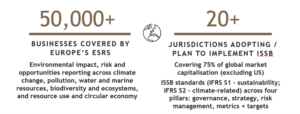Scott Gardiner, Emma Newnham, Linda Le and Emily Fox unpack guidance from the International Sustainability Standards Board (ISSB) and the European Commission (EC) aimed at helping entities comply with their reporting requirements.
Sustainability reporting requirements are proliferating around the world – and along with them, different standards and frameworks. This can cause confusion and inconsistency for entities facing various and sometimes conflicting requirements.
The ISSB and the EC have joined forces to provide practical support that explains how companies can comply with both the ISSB’s IFRS Sustainability Disclosure Standards (ISSB Standards) and the European Sustainability Reporting Standards (ESRS), making it easier for entities to report. The result – a 33-page joint interoperability guidance (Guidance) – was released in May 2024.
The aim was to promote a common language and understanding of the ESG impacts and performance of businesses. The European Financial Reporting Advisory Group (EFRAG) also took part. This is part of the ISSB’s wider efforts to create a global baseline of sustainability standards, bringing certainty and transparency for investors.
We expect further standardisation over time, as IFRS works with jurisdictions.
The harmonisation effort marks a significant leap toward simplifying complex requirements. Here is our short take on what you need to know.

The guidance unpacked
The Guidance is a game-changer for entities faced with the task of climate-related disclosures. Here is what it entails:
- General principles of reporting: A high-level commentary on interoperability, with regards to materiality, presentation and disclosures for sustainability topics other than climate,
- Common climate-related disclosures table: A comprehensive comparison of climate-related disclosure requirements between the ESRS and ISSB standards, and
- Analysis notes: detailed insights for entities starting with either set of standards on complying with both.
Which entities are covered (and benefit)?
This Guidance targets entities that are under the obligation to comply with both the ESRS and ISSB Standards. It helps those entangled in dual compliance.
“From major economies to emerging markets, jurisdictions around the world… are recognising the value of the ISSB Standards. Supporting completion of their regulatory processes, as well as the engagement with other jurisdictions around the world, is our priority in the near future in creating the global baseline of proportionate, high-quality sustainability-related financial disclosures.” – ISSB Chair Emmanuel Faber
When does it apply from?
The Guidance was published on 2 May 2024. It is intended to help entities through the transition process for both ESRS and ISSB Standards. It is a point-in-time analysis of differences, does not include all standards and can change over time.
What are the implications?
The Guidance aims to streamline the compliance process by:
- Clarifying overlaps and differences, and
- Providing a clear framework for reporting.
It is important to understand that this Guidance is not a standalone document but a companion to the full standards.
The Guidance also does not include the non-mandatory disclosures or non-mandatory calculation guidance in ESRS or ISSB Standards.
Entities are expected to read the Guidance in conjunction with the relevant standards and cannot rely on the Guidance in isolation. The Guidance is also not a formal statement of equivalence.
Additional interoperability efforts
Beyond the Guidance, the ISSB is committed to fostering interoperability with other frameworks:
- IFRS Sustainability Disclosure Taxonomy: Released on April 30, 2024, this taxonomy is a step towards aligning with other international taxonomies. The ISSB announced it is taking steps to ensure it can help facilitate interoperability with other taxonomies when necessary.
- Global adoption: Countries like Canada, Japan and Singapore are consulting on the integration of the ISSB Standards into their regulations (by adoption or other use), signalling a move towards a unified global approach. Australia and Malaysia are among other jurisdictions that have had similar consultations.
The bigger picture
Efficiency is at the heart of this Guidance which ensures that entities can navigate the reporting landscape with a clearer map, reducing duplication of efforts and fostering confidence in their disclosure processes.
We are watching for further developments.
Want to know more about sustainability reporting and disclosures? Read more of our insights, including our annual take on the reporting practices of the ASX50.
- Update on mandatory sustainability reporting in Australia
- Breaking new ground: ASX50 sustainability reporting and governance in 2023 – KWM
- EU’s sustainability due diligence clock starts now: CSDDD is in force!
- KWM ESG Quarterly Compass: Sustainability disclosure in the frame
- From Owl Advisory by KWM: How Australian companies are preparing for climate reporting and setting climate plans








